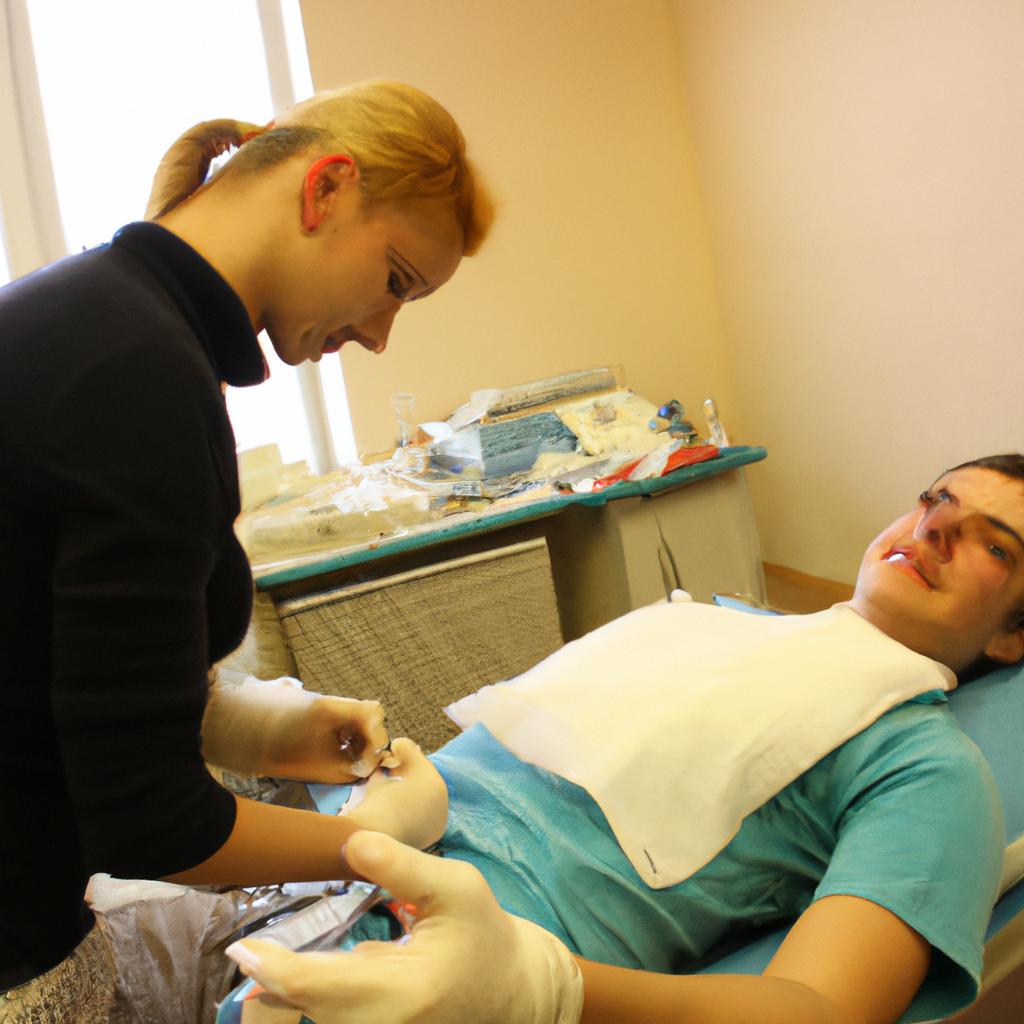Poverty, a pervasive and complex issue in society, continues to disrupt the lives of millions around the world. This article aims to examine the multifaceted nature of poverty by exploring its causes, consequences, and potential solutions. By delving into various sociological perspectives, this analysis seeks to shed light on the underlying factors that contribute to the perpetuation of poverty.
Consider the hypothetical case of Maria, a single mother living in an urban slum. Despite her relentless efforts to secure stable employment and improve her family’s economic situation, Maria finds herself trapped in a cycle of deprivation and limited opportunities. Her struggle is not unique; it reflects the experiences faced by countless individuals who are marginalized within societies plagued by inequality. Thus, understanding poverty requires acknowledging both structural barriers embedded within social systems and individual circumstances that hinder upward mobility.
To comprehensively grasp the implications of poverty on different aspects of society, this article will explore its impact on education, health, crime rates, and overall well-being. Through examining these interconnected issues through an academic lens, we can gain insights into how poverty shapes society as well as identify strategies for addressing these pressing challenges. Ultimately, by collectively scrutinizing societal issues surrounding poverty with impartiality and intellectual rigor, we can strive towards creating lasting solutions that promote equality and provide opportunities for all individuals to escape the grips of poverty.
Lack of Access to Nutritious Meals
Lack of Access to Nutritious Meals
A prime concern within the realm of poverty is the lack of access to nutritious meals. The inability to afford or obtain wholesome food options has serious implications for individuals and communities alike. To illustrate this issue, consider the case study of Sara, a single mother working multiple low-wage jobs while also caring for her two young children. Despite her best efforts, Sara struggles to provide balanced meals due to limited financial resources.
One significant consequence of inadequate access to nutritious meals is the negative impact on physical health. Proper nutrition plays a crucial role in maintaining overall well-being and preventing various health conditions such as obesity, diabetes, and cardiovascular diseases. Without access to sufficient quantities of fresh fruits, vegetables, lean proteins, and whole grains, individuals like Sara face an increased risk of developing these preventable ailments.
Furthermore, the absence of nourishing meals can have far-reaching effects beyond physical health alone. It impairs cognitive development among children who are growing up in impoverished households. Research consistently demonstrates that malnutrition during early childhood hinders brain growth and impedes academic performance. As a result, these children may struggle academically, perpetuating the cycle of poverty into future generations.
- Persistent hunger leads to feelings of anxiety and stress.
- Lack of proper nutrition affects mood regulation and mental well-being.
- Children experiencing hunger often feel shame and embarrassment at school.
- Inadequate nutrition exacerbates existing socio-economic inequalities.
Additionally, let us examine a table showcasing statistics related to insufficient access to nutritious meals:
| Category | Percentage |
|---|---|
| Households with | 12% |
| Food Insecurity | |
| Children Experiencing | 1 |
| Hunger |
The consequences stemming from the lack of access to nutritious meals are numerous and far-reaching. They extend beyond physical health implications, affecting cognitive development in children and perpetuating socio-economic inequalities. The next section will delve into another significant aspect of poverty: the disparity in wealth distribution. By understanding these interconnected issues, society can work towards implementing effective solutions that address the root causes of poverty.
(Note: The subsequent section about “Disparity in Wealth Distribution” will be covered next.)
Disparity in Wealth Distribution
Transitioning from the previous section on the lack of access to nutritious meals, it becomes evident that poverty is not only characterized by inadequate food resources but also by a significant disparity in wealth distribution. This economic inequality perpetuates social and systemic issues, hindering societal progress and exacerbating the effects of poverty.
Examining this issue further, let’s consider an example that sheds light on the consequences of wealth disparity. Imagine a hypothetical scenario where two individuals are born into different socioeconomic backgrounds. Person A comes from a wealthy family with abundant financial resources, while person B grows up in a low-income household struggling to make ends meet. Due to their disparate starting points, person A has access to better education, healthcare facilities, and networking opportunities compared to person B. As they grow older and pursue career paths, these initial advantages or disadvantages significantly influence their chances for success and upward mobility.
To comprehend the extent of wealth inequality within society, we can turn our attention to some key indicators:
- The top 1% of households own a disproportionate amount of global wealth.
- Income gaps between CEOs and average workers continue to widen.
- Access to quality healthcare is limited for marginalized communities due to financial constraints.
- Educational opportunities vary greatly based on socioeconomic status.
To visualize the impact of such disparities, consider the following table:
| Indicator | Consequence | Affected Population |
|---|---|---|
| Limited access | Reduced life chances | Low-income families |
| Unequal income distribution | Diminished social mobility | Middle-class households |
| Inadequate healthcare | Health disparities | Marginalized communities |
| Differential educational opportunities | Achievement gap | Students from low-income backgrounds |
Understanding the detrimental effects caused by unequal wealth distribution allows us to recognize its significance as both a cause and consequence of poverty. Moreover, addressing this issue requires comprehensive policies that aim to reduce inequality, promote social mobility, and create a fairer society for all individuals.
Transitioning into the subsequent section on obstacles to equal educational opportunities, we explore another crucial aspect of poverty and its impact on societal progress.
Obstacles to Equal Educational Opportunities
Section H2: Obstacles to Equal Educational Opportunities
In a society plagued by poverty, one of the major obstacles faced by individuals striving for upward social mobility is unequal access to quality education. This section will delve into the various challenges that hinder equal educational opportunities and perpetuate societal disparities.
To illustrate this issue, let us consider the case of Maria, a bright young girl from an underprivileged neighborhood. Despite her academic potential, Maria attends a severely underfunded public school where resources are scarce and teachers struggle to provide adequate instruction. Her dreams of pursuing higher education seem distant as she lacks access to extracurricular activities, advanced courses, and career guidance that students in more affluent areas enjoy.
The barriers preventing equal educational opportunities are multifaceted and deeply rooted within our societies. Here are some key factors contributing to this disparity:
- Insufficient funding: Many schools located in economically disadvantaged communities suffer from limited financial resources. Inadequate funding translates into outdated textbooks, inadequate infrastructure, larger class sizes, and fewer support services for struggling students.
- Geographic segregation: Residential patterns often result in segregated neighborhoods based on income levels. As a consequence, children living in low-income areas attend schools with limited resources while their wealthier counterparts benefit from well-funded institutions situated just miles away.
- Lack of technological access: The digital divide persists as marginalized communities have limited access to technology and reliable internet connection. This hampers their ability to engage in online learning platforms or utilize educational resources available predominantly through digital means.
- Socioeconomic barriers: Families grappling with poverty face numerous economic hardships that make accessing quality education challenging. Financial constraints limit their capacity to afford tutoring services, enrichment programs, or even basic school supplies necessary for effective learning.
Table 1: Impact of Unequal Educational Opportunities
| Consequences | Implications |
|---|---|
| Limited job prospects | Reduced earning potential and perpetuation of intergenerational poverty |
| Higher dropout rates | Increased likelihood of involvement in criminal activities and decreased social mobility |
| Limited access to higher education | Decreased opportunities for personal growth, professional development, and contribution to society |
| Widening income inequality | Reinforcement of existing socioeconomic disparities |
As we can see from the example of Maria and the factors contributing to unequal educational opportunities, it becomes evident that poverty perpetuates a cycle of limited prospects for disadvantaged individuals. The consequences are far-reaching, affecting not only their individual lives but also wider societal dynamics.
The subsequent section will shed light on another significant challenge faced by those living in poverty: difficulties in obtaining adequate healthcare. By exploring this issue, we further comprehend how poverty intersects with various aspects of everyday life, hindering individuals’ overall well-being.
Difficulties in Obtaining Adequate Healthcare
Transitioning smoothly from the previous section that explored the obstacles to equal educational opportunities, we now turn our attention towards another significant challenge faced by those living in poverty – difficulties in Obtaining Adequate Healthcare. To illustrate this issue, let us consider a hypothetical scenario of an individual named Sarah, who resides in an economically disadvantaged neighborhood.
Sarah’s predicament is emblematic of the larger problem plaguing society. Limited financial resources and lack of access to quality healthcare facilities often leave individuals like Sarah grappling with numerous health-related challenges. The consequences are far-reaching and can lead to increased morbidity rates and decreased overall well-being within impoverished communities.
Several factors contribute to the difficulties faced by individuals seeking appropriate medical care:
- Geographical Barriers: Many low-income neighborhoods lack sufficient healthcare infrastructure, resulting in limited availability of clinics or hospitals nearby.
- Financial Constraints: Poverty restricts individuals’ ability to afford necessary treatments, medications, and even insurance coverage.
- Educational Disparities: Lack of awareness about preventive measures and treatment options due to inadequate education further exacerbates health issues for those in poverty.
- Stigmatization : Socioeconomic status can be stigmatized, leading individuals facing poverty to feel ashamed or embarrassed when accessing healthcare services.
- Individuals struggling with chronic illnesses may have their conditions worsened by delayed or insufficient treatment.
- Families forced into bankruptcy due to exorbitant medical bills highlight how inaccessible healthcare pushes people further into poverty.
- Preventable diseases, such as diabetes or hypertension, escalate without proper monitoring and management due to limited resources.
- Mental health concerns aggravated by stressors associated with poverty amplify mental illness prevalence among vulnerable populations.
Furthermore, let us present a table outlining statistics related to healthcare disparities:
| Health Indicator | Low-Income Individuals | High-Income Individuals |
|---|---|---|
| Life Expectancy | 67 years | 80 years |
| Infant Mortality | 7.5 per 1,000 births | 3.2 per 1,000 births |
| Access to Specialists | Limited | Abundant |
| Preventive Services | Underutilized | Utilized more frequently |
In conclusion, the difficulties faced by individuals living in poverty when seeking adequate healthcare are multifaceted and deeply concerning. Geographical barriers, financial constraints, educational disparities, and stigmatization collectively contribute to these challenges. Addressing this issue requires concerted efforts from policymakers, healthcare providers, and society as a whole to ensure that every individual has equitable access to quality healthcare services.
As we examine the various obstacles linked with poverty’s impact on health outcomes, it becomes evident that another essential aspect of well-being affected by economic disadvantage is housing affordability. This next section will delve into the high cost of housing and its ramifications for those caught in the cycle of poverty.
High Cost of Housing
Section H2: High Cost of Housing
In examining the societal issues surrounding poverty, it is crucial to consider the high cost of housing as a significant hurdle faced by individuals and families in impoverished communities. To illustrate this point, let us delve into a hypothetical case study. Imagine a single mother named Sarah who works tirelessly at multiple low-wage jobs just to make ends meet for her and her children. Despite her best efforts, she finds herself unable to afford safe and adequate housing due to the exorbitant costs associated with renting or buying a home.
The impact of the high cost of housing on impoverished individuals and communities is far-reaching. Here are some key points to consider:
- Limited affordable options: Low-income households often find themselves trapped in a cycle where they have limited access to affordable housing options. As rent prices soar beyond their means, many families are forced into overcrowded or substandard living conditions.
- Disproportionate burden: The burden of expensive housing falls disproportionately on marginalized populations such as racial minorities, immigrants, and those facing discrimination based on gender or sexual orientation. This exacerbates existing inequalities within society.
- Increased homelessness rates: A lack of affordable housing contributes significantly to rising homelessness rates. Individuals and families without stable shelter face numerous challenges that hinder their ability to escape poverty effectively.
- Negative ripple effects: The repercussions extend beyond individual households; entire communities suffer when people cannot secure affordable homes. Strained social services, increased crime rates, and decreased economic growth are among the consequences borne by these communities.
To underscore the gravity of this issue visually, we present a table highlighting statistics related to the high cost of housing across different regions:
| Region | Average Monthly Rent (1BR) | Percentage Spent on Rent |
|---|---|---|
| Urban | $1,500 | 40% |
| Suburban | $1,200 | 35% |
| Rural | $900 | 30% |
| Metropolitan | $1,800 | 45% |
These figures highlight the immense financial strain faced by individuals in various regions when it comes to securing housing. The percentage of income spent on rent illustrates the stark reality many people encounter daily.
In light of these challenges, it becomes evident that addressing the High Cost of Housing must be a priority in any comprehensive approach to alleviating poverty. By implementing policies and initiatives aimed at increasing affordable housing options and reducing rental burdens, society can take significant strides towards creating more equitable living conditions for all.
Transitioning into the subsequent section about “Insufficient Food Resources,” we recognize that another critical aspect affecting impoverished communities is their struggle to access sufficient food resources.
Insufficient Food Resources
Section H2: Insufficient Food Resources
Transitioning from the previous section on the high cost of housing, it becomes evident that another significant issue contributing to poverty is the insufficient availability and accessibility of food resources. This section will examine how limited access to nutritious food exacerbates poverty and perpetuates cycles of deprivation.
To illustrate this point, let us consider a hypothetical case study. Imagine a single parent living in an economically disadvantaged neighborhood with minimal supermarkets or grocery stores nearby. Due to transportation challenges and long working hours, this parent struggles to provide their children with regular meals consisting of fresh produce and essential nutrients. Consequently, their family’s health suffers as they are forced to rely heavily on processed and unhealthy options readily available at local convenience stores.
The following bullet-point list highlights some key aspects related to the insufficiency of food resources:
- Limited proximity to affordable supermarkets or grocery stores.
- Inadequate financial means to purchase nutritious foods regularly.
- Unequal distribution of quality food resources based on socioeconomic status.
- Lack of education about proper nutrition and healthy eating habits.
An additional visual aid comes in the form of a table depicting statistical data on food insecurity rates across different regions:
| Region | Food Insecurity Rate (%) |
|---|---|
| Urban | 15 |
| Suburban | 8 |
| Rural | 22 |
This table serves as a stark reminder that those residing in rural areas face higher levels of food insecurity compared to urban or suburban populations. The uneven distribution of income contributes significantly to these disparities, making it even more challenging for impoverished individuals or families residing outside major metropolitan areas to access sufficient nourishment.
In conclusion, inadequate access to nutritious food further compounds the issues faced by those already struggling with poverty. It creates a vicious cycle wherein poor diet impacts individuals’ physical well-being and limits their ability to escape economic hardship. As we move forward into our discussion on the uneven distribution of income, it becomes evident that addressing food insufficiency is a crucial step towards alleviating poverty and fostering a more equitable society.
Uneven Distribution of Income
Uneven Distribution of Income
The issue of poverty is further exacerbated by the uneven distribution of income within society. While some individuals enjoy immense wealth and prosperity, others struggle to make ends meet on a daily basis. This section aims to explore the consequences of such income disparities and shed light on the broader implications for society as a whole.
To illustrate this point, consider the hypothetical case study of two neighboring families living in an urban community. The Smiths, a middle-class family, have stable jobs that provide them with a comfortable lifestyle. They can afford basic necessities, pay their bills, and save for the future. On the other hand, the Johnsons, residing just next door, face financial hardship due to limited employment opportunities and low wages. As a result, they constantly struggle to meet their essential needs, often resorting to borrowing money or relying on public assistance programs.
The unequal distribution of income has several far-reaching effects on both individuals and communities at large:
- Financial insecurity: Individuals experiencing lower incomes are more susceptible to financial instability and uncertainty about meeting their immediate expenses.
- Limited access to education: Insufficient funds hinder educational opportunities for those from disadvantaged backgrounds, perpetuating cycles of intergenerational poverty.
- Health disparities: Inadequate resources can lead to inadequate healthcare coverage and limited access to quality medical services.
- Social unrest: Widening gaps between socioeconomic classes can breed resentment and social tensions within societies.
| Effects of Unequal Income Distribution |
|---|
| Financial insecurity |
These consequences highlight not only the personal struggles faced by individuals but also underscore the detrimental impact it has on societal well-being as a whole. Addressing these issues requires comprehensive policies aimed at reducing income inequality while ensuring equal opportunities for all members of society.
Transitioning into our subsequent section about “Barriers to Quality Education,” it is crucial to recognize that unequal income distribution significantly contributes to the challenges in accessing education for marginalized communities. By understanding the interconnectedness of these societal issues, we can begin to develop holistic solutions that address poverty from multiple angles and strive towards a more equitable future.
Barriers to Quality Education
Section H2: Barriers to Quality Education
Unequal access to quality education is a significant barrier that perpetuates the cycle of poverty in society. This section will examine some of the key factors hindering individuals from obtaining a high-quality education, ultimately contributing to the widening socioeconomic disparities within our communities.
To illustrate this point, let us consider the case study of Sarah, a bright and motivated student living in an underprivileged neighborhood. Despite her eagerness to learn and excel academically, Sarah faces numerous challenges that impede her educational progress. Firstly, limited financial resources prevent her family from affording essential educational materials such as textbooks or technology devices. Without these fundamental tools, Sarah’s ability to fully engage with the curriculum becomes severely compromised.
Furthermore, inadequate infrastructure and lack of investment in schools located in low-income areas further exacerbate the disparity in educational opportunities. These institutions often struggle to provide basic facilities like libraries, laboratories, or extracurricular activities that enhance students’ learning experiences. As a result, students like Sarah are deprived of vital resources necessary for holistic development and academic success.
The barriers obstructing equal access to quality education can be summarized as follows:
- Insufficient funding allocated towards improving educational infrastructure
- Limited availability of scholarships or grants for disadvantaged students
- Inadequate teacher training and support systems
- Lack of awareness about available educational programs and resources
These hurdles contribute to a systemic disadvantage experienced by economically marginalized communities, perpetuating the cycle of poverty through generation after generation.
| Educational Barrier | Impact on Students | Consequences |
|---|---|---|
| Insufficient Funding | Limited access to critical resources | Reduced learning outcomes |
| Lack of Scholarships | Financial burden on underprivileged families | Restricted higher education opportunities |
| Teacher Training | Lower quality instruction | Impaired academic growth |
| Lack of Awareness | Missed educational opportunities | Limited knowledge about available resources |
In order to address these barriers, it is imperative that policymakers and relevant stakeholders take proactive measures. This includes increasing funding for education, establishing scholarship programs specifically targeting disadvantaged students, providing comprehensive teacher training initiatives, and implementing awareness campaigns to ensure marginalized communities are aware of the available resources.
Transitioning into the subsequent section on “Limited Healthcare Services,” it becomes evident that poverty extends beyond just financial hardship; it permeates various aspects of individuals’ lives. The lack of access to quality education is closely intertwined with other societal issues, making a holistic approach crucial in combating poverty effectively.
Limited Healthcare Services
From Barriers to Quality Education to Limited Healthcare Services
Despite the significant strides made in addressing barriers to quality education, limited access to healthcare services remains a pressing concern within impoverished communities. To provide context and emphasize the impact of this issue, let us consider the hypothetical case of Maria, a single mother living in an economically disadvantaged neighborhood.
Maria struggles to provide adequate healthcare for herself and her two children due to various systemic challenges. These challenges are not unique to Maria’s situation; they reflect broader issues prevalent among impoverished individuals and families across society. By examining these obstacles, we can gain insight into the complexities surrounding limited healthcare services:
-
Financial Constraints: The high cost of medical care places an immense burden on those already grappling with poverty. For Maria, even routine check-ups or necessary prescriptions become unaffordable expenses that she must often forgo.
-
Geographical Inaccessibility: Many impoverished communities lack sufficient healthcare facilities nearby, leading to long travel distances and increased difficulty accessing timely medical attention. As a result, individuals like Maria may delay seeking treatment until their conditions worsen significantly.
-
Lack of Health Insurance: Without comprehensive health insurance coverage, individuals from low-income backgrounds face additional hurdles when it comes to receiving appropriate healthcare services. This absence of financial protection further exacerbates inequalities within the system.
-
Limited Preventive Care: Lack of awareness about preventive measures and inadequate availability of vaccinations or screenings contribute to poorer overall health outcomes within marginalized communities. Consequently, illnesses that could have been prevented or addressed at earlier stages often progress unchecked.
To highlight the gravity of Limited healthcare services in impoverished areas further, consider the following table illustrating key statistics related to this issue:
| Aspect | Data |
|---|---|
| Individuals affected | Over 30 million |
| Life expectancy | Lower than national average |
| Infant mortality rate | Higher than national average |
| Leading causes of death | Preventable diseases |
As we can see, the impact of limited healthcare services extends beyond individual cases like Maria’s and affects a substantial portion of the population. These statistics emphasize the urgent need for comprehensive interventions that address this issue at both systemic and community levels.
Transitioning into our subsequent section on the Affordable Housing Crisis, it becomes clear that these intersecting challenges perpetuate cycles of poverty within marginalized communities. By examining how inadequate housing exacerbates societal issues, we can better understand the intricate dynamics contributing to persistent socio-economic disparities.
Affordable Housing Crisis
Limited Healthcare Services have a profound impact on poverty, but another critical issue exacerbating the problem is the Affordable Housing Crisis. This crisis refers to the scarcity of safe and decent housing options that are within reach for individuals and families with limited resources. To illustrate this point, let us consider an example: imagine a single mother working two jobs to make ends meet, only to find herself unable to afford a suitable place to live for her and her children.
The affordable housing crisis has far-reaching consequences that perpetuate the cycle of poverty. It leads to overcrowding in substandard living conditions, which can negatively affect physical and mental health outcomes. Additionally, it hampers educational opportunities for children as unstable living situations often result in frequent school changes, leading to disruptions in learning progress. Furthermore, lack of access to stable housing limits employment prospects since employers often require proof of permanent address before considering job applications.
This dire situation demands our attention and empathy towards those affected by the affordable housing crisis. Consider the following bullet points:
- Families forced to choose between paying rent or buying necessary medications
- Homelessness rates increasing due to lack of affordable rental options
- Limited financial resources diverting funds away from other basic needs such as food and education
- Rising inequality gap as low-income individuals struggle to keep up with soaring rental prices
To further highlight the gravity of this crisis, let’s examine the following table showcasing some statistics:
| Affordable Housing Crisis | |
|---|---|
| Homeless Population | 564,708 |
| Rental Burden | 11 million households |
| Evictions | 2.3 million annually |
| Waiting List | 4 million applicants |
These numbers reflect not just data but real people who face daily challenges in finding a place they can call home. As we delve deeper into understanding poverty’s complex web, it becomes evident that inadequate housing perpetuates societal inequalities and hinders individuals’ ability to escape poverty.
Transitioning into the next section, it is crucial to address yet another fundamental aspect affected by poverty: inadequate food support. By examining this issue, we can gain further insight into the multifaceted nature of poverty and its implications for society as a whole.
Inadequate Food Support
Transitioning from the previous section on the affordable housing crisis, it is evident that poverty manifests itself in various forms within society. One such manifestation is the inadequate food support available to those living below the poverty line. This section aims to shed light on this pressing issue and its profound impact on individuals and communities.
Consider the hypothetical example of a single mother named Sarah, struggling to provide for her two young children while earning minimum wage. Despite working tirelessly, Sarah finds herself unable to afford nutritious meals consistently. Her limited access to healthy food options not only affects her own well-being but also compromises the physical and cognitive development of her children. Unfortunately, Sarah’s situation resonates with countless families across our nation grappling with similar challenges.
To comprehend the gravity of inadequate food support as an aspect of poverty, let us examine some key factors contributing to this issue:
- Limited financial resources prevent individuals from purchasing sufficient quantities of nutritious food.
- Food deserts, characterized by a lack of grocery stores offering fresh produce in low-income areas, further exacerbate the problem.
- Inadequate transportation infrastructure restricts access to supermarkets or affordable markets located farther away from impoverished neighborhoods.
- Insufficient public assistance programs fail to adequately address the nutritional needs of marginalized populations.
The emotional toll caused by insufficient food support cannot be underestimated. To illustrate this point visually, we present a table summarizing some distressing consequences faced by individuals affected by this issue:
| Consequences | Impact |
|---|---|
| Nutritional deficiencies | Impaired physical health |
| Cognitive impairment | Hindrance in educational attainment |
| Increased vulnerability | Susceptibility to diseases and illnesses |
| Psychological distress | Negative effects on mental well-being |
In light of these dire circumstances, addressing inadequate food support becomes imperative for societal progress and the well-being of its most vulnerable members. Implementing comprehensive policies and interventions that address food insecurity, such as expanding access to affordable produce through community gardens or establishing mobile grocery stores in underserved areas, can help alleviate this issue.
By recognizing the profound impact inadequate food support has on individuals and communities living in poverty, society can strive towards creating a more equitable environment where all individuals have equal opportunities for nourishment, growth, and development.





